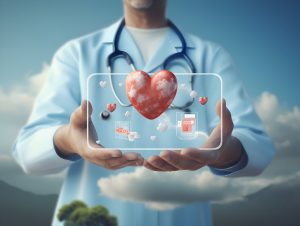Table of contents
- Introduction
- The Foundations and Principles of Person-Centered Care
- The Shift to a Holistic Care Approach
- Technology’s Role in Elevating PCC
- Empowering Patients in their Healthcare Journey
- The Integral Role of Healthcare Professionals-Person-Centered Care
- Addressing the Nuances: Cultural Competency and Health Literacy
- The Tangible Benefits of Patient-Centered Care
- Conclusion
- FAQs
Introduction
Welcome to the dynamic world of healthcare! A realm where innovations continually shape our experiences. At the forefront of these changes stands Patient-Centered Care. So, what exactly is this term that’s creating waves?
Patient-Centered Care, often known as Person-Centered Care or Individualized Care Approach, is a healthcare approach where patients actively participate in their own medical decisions. It’s a method that revolves around the patient’s individual needs, values, and preferences. In essence, it’s healthcare designed for the patient, by the patient, and with the patient.
But this hasn’t always been the norm. Over the years, our healthcare system underwent a massive transformation. Previously, the focus was largely on diseases and their treatments. Now, we’re witnessing a shift towards prioritizing the patient’s overall well-being. This evolution towards Patient-Centric Care signifies a move from a strictly clinical approach to one that values the patient’s holistic experience.
Stay with us, as we dive deep into this groundbreaking shift, uncovering how it’s transforming healthcare settings around the world.

The Foundations and Principles of Person-Centered Care
The transition to a more patient-oriented healthcare system isn’t merely a trend—it’s deeply rooted in established principles and practices. Understanding these foundational concepts is crucial to grasp the significance of Person-Centered Care.
Personalized Medicine
At the heart of modern healthcare lies a powerful idea: Not every treatment fits all. We’re now in an era where doctors can tailor treatments based on an individual’s unique genetic makeup, lifestyle, and environment. This Personalized Medicine ensures that care is not just effective but also specific to each person’s needs.
The Core Principles of Patient-Centered Care
Various organizations and experts have identified key principles that uphold the essence of Person-Centered Care:
The 4 Principles of Person-Centered Care
- Individuality: Recognizing every patient as a unique individual with specific needs and preferences.
- Rights: Respecting and protecting the rights of each patient, ensuring they’re treated with dignity and fairness.
- Choice: Allowing patients to make informed decisions and have a say in their care.
- Privacy: Ensuring patient confidentiality and safeguarding personal information.
The 7 Principles of Person-Centered Care
Independence: Supporting patients to maintain autonomy in their care decisions.
Dignity: Treating patients with respect, irrespective of their health condition.
Respect: Valuing each patient’s beliefs, culture, and values.
The 5 Principles of Person-Centered Care Practice:
- Respectful Partnership: Working alongside patients as partners in care.
- Power and Responsibility Sharing: Empowering patients and sharing responsibilities in decision-making.
- Accessibility: Providing care that is accessible and fits into the patient’s world.
- Flexibility: Adapting services and treatments to fit individual needs.
- Professional Approach: Care providers continuously updating their skills to best serve the patients.
The 6 Elements of Person-Centered Care emphasize on
- Understanding People: Knowing patients beyond their health conditions.
- Positive Interactions: Engaging in constructive and supportive communications.
- An Enabling Environment: Creating settings where patients feel safe and supported.
- Supporting Staff: Ensuring healthcare staff have the right tools and training.
- Proactive Approach to Health: Anticipating and planning for health needs.
- Continuity and Consistency: Ensuring a seamless care experience.
Lastly, The 3 Central Levels of the Person-Centered Approach involve:
- Engagement: Actively involving patients in their care journey.
- Empowerment: Giving patients the tools and information to manage their health.
- Enrichment: Enhancing the overall quality of life for patients.

The Shift to a Holistic Care Approach
Stepping into the healthcare of today, there’s a noticeable change in the air. The focus isn’t just on treating ailments anymore. Instead, there’s a beautiful blend of the traditional with the innovative. And leading this blend is the Holistic Care Approach.
At its heart, Patient-Centered Care emphasizes treating the patient as a whole. It’s not just about the physical symptoms. It’s about understanding and addressing the mind, body, and spirit in tandem. Think of it like piecing together a puzzle. Each piece, whether it’s mental wellness, physical health, or spiritual peace, plays a crucial role. When they come together, the picture becomes clear: a comprehensive approach to health.
So, why is this Holistic Approach so significant in Person-Centered Care? Well, it’s simple. By acknowledging the entirety of a patient’s experience, we can offer better, more tailored care. Imagine a scenario where a patient’s physical symptoms are treated, but their mental distress is overlooked. They may recover physically, but the underlying stress or emotional pain could still linger. By embracing a holistic mindset, healthcare providers ensure that patients truly heal, both inside and out.

Technology’s Role in Elevating PCC
In our rapidly evolving world, technology and healthcare have intertwined in extraordinary ways. One could even say technology has become the linchpin in enhancing Patient-Centered Care (PCC).
A shining example is the rise of Electronic Health Records (EHRs). Gone are the days of endless paper trails and manual record-keeping. EHRs have streamlined patient information, making it easily accessible to healthcare professionals. The immediate impact? A quicker, more efficient, and comprehensive view of a patient’s history. This not only saves precious time but also ensures that the care provided is based on a patient’s entire medical narrative.
Then we have Telehealth & Telemedicine. These aren’t just buzzwords; they’re a revolution. Especially in times when physical presence can be challenging, these platforms bridge the gap. They bring healthcare right to a patient’s doorstep. Whether it’s a quick consultation, a follow-up, or even therapy, patients can now access medical services from the comfort of their homes. This is Person-Centered Care in its truest form, adapting to the needs and comforts of the individual.
Lastly, let’s touch on Remote Patient Monitoring. Imagine a world where healthcare providers can track a patient’s vitals and health metrics in real-time, regardless of distance. That’s not science fiction; it’s the reality we’re heading towards. With wearables and smart devices, patient data can be monitored and analyzed continuously. The benefits? Immediate responses to any irregularities, personalized treatment plans, and most importantly, proactive healthcare.

Empowering Patients in their Healthcare Journey
One clear shift we’re seeing in today’s healthcare landscape is the move from passive to active roles for patients. In fact, a major part of the Patient-Centered Care movement is about giving patients more say and control. Let’s dive into this.
Firstly, let’s talk about Shared Decision Making. Remember the times when doctors would tell patients what they needed, and that was the end of it? Well, times have changed. Now, there’s a two-way street. Both doctors and patients sit at the table, discussing the best course of action. It’s like a partnership where both voices count. This collaboration ensures that care aligns with a patient’s personal values, preferences, and needs.
Next up, Patient Engagement. So, why all the buzz around it? Simply put, when patients are engaged, they’re more informed and proactive about their health. This directly translates to better health outcomes. It’s like studying for an exam; the more involved and prepared you are, the better the results. For healthcare providers, having engaged patients means they can provide more tailored, efficient care.
Lastly, you might be wondering, what’s a real-world example of Patient-Centered Care? Let’s paint a picture. Imagine a diabetes patient. In a traditional setting, they might receive a standard diet plan and medication. But in a patient-centered approach, a healthcare provider would discuss the patient’s lifestyle, food preferences, work schedule, and more. Together, they’d craft a unique plan that not only manages the diabetes but also aligns with the patient’s life.
In a nutshell, by focusing on collaboration and engagement, the healthcare system becomes more responsive, adaptive, and, importantly, effective. And that, right there, is the heart and soul of Person-Centered Care.
The Integral Role of Healthcare Professionals-Person-Centered Care
Healthcare is like a vast, interconnected web. And at its core? Healthcare professionals. Their role isn’t just important; it’s foundational. Let’s break this down.
Starting off, consider Interdisciplinary Teams. In the past, you might have had one doctor handling most of your health concerns. But now, there’s a shift. Imagine a team where a nutritionist, therapist, nurse, and physician all work together for you. This isn’t just teamwork; it’s a holistic approach ensuring every aspect of your health is covered. By working in tandem, these teams can provide a well-rounded and comprehensive Patient-Centered Care experience.
Moving on, we can’t overlook the power of Empathy in Healthcare. We’ve all been there—a rushed appointment where you felt more like a number than a person. Empathy flips this on its head. Healthcare providers now strive to truly listen and understand. It’s not just about treating an illness; it’s about understanding the person behind it. And the effects? Remarkable. When patients feel heard and valued, their trust in the healthcare process grows, leading to better cooperation and outcomes.
So, coming to the key question: What really matters for Patient-Centered Care? At its heart, it’s about respect, understanding, and collaboration. It’s about recognizing each patient’s unique story and needs. For healthcare professionals, it’s not just about medical knowledge; it’s about communication, teamwork, and, above all, compassion.
In short, the future of healthcare is bright, and it’s all thanks to the unwavering dedication and evolution of our healthcare professionals. Their focus on teamwork and empathy is setting the stage for a system where every patient truly feels at the center of their care journey.
Addressing the Nuances: Cultural Competency and Health Literacy
Diving deeper into Patient-Centered Care, we find layers that often get overshadowed. Two of these critical layers? Cultural competency and health literacy. Let’s unpack them.
First off, let’s tackle Cultural Competency in Healthcare. In an ever-globalizing world, healthcare isn’t one-size-fits-all. Different cultures have diverse health beliefs, practices, and needs. Recognizing and respecting these differences isn’t just good practice; it’s essential. For Patient-Centered Care to truly shine, healthcare providers must tailor their approach to each patient’s cultural background. In doing so, they ensure that care is not only effective but also respectful and inclusive.
Next, we have Health Literacy Improvement. Ever left a doctor’s appointment feeling more confused than before? You’re not alone. It’s vital for patients to understand their health, treatments, and choices. So, in comes the focus on improving health literacy. This means presenting health information in easy-to-understand terms, ensuring patients are well-informed and empowered.

The Tangible Benefits of Patient-Centered Care
Now, onto the meaty stuff. What does all this focus on PCC really bring to the table? Well, plenty.
For starters, there’s a direct link between PCC and Patient Satisfaction Metrics. When care is tailored, respectful, and inclusive, patients naturally feel more satisfied. They feel seen, heard, and valued. This, in turn, boosts trust and confidence in healthcare providers.
Moreover, PCC leads to improved Patient Outcomes. It’s simple math. Better understanding plus tailored care equals more effective treatment. When patients are engaged, informed, and part of the decision-making, they’re more likely to follow through with treatments, leading to better health outcomes.
Challenges and Solutions
Of course, it’s not all smooth sailing. Implementing PCC comes with its hurdles.
Among the top Obstacles hospitals face in PCC implementation are resistance to change, lack of training, and resource constraints. Changing long-standing practices can be daunting for healthcare institutions.
However, there are Strategies for overcoming these challenges. Continuous training programs, patient feedback loops, and interdisciplinary teamwork can pave the way for smoother PCC integration. By committing to these solutions, hospitals can ensure they’re not just meeting but exceeding patient expectations.

Conclusion
Wrapping things up, the journey of Patient-Centered Care (PCC) is both exciting and transformative. From its humble beginnings to its current prominent role, it’s clear that PCC is here to stay.
Taking a step back, it’s remarkable to see how far we’ve come. Before, healthcare was a one-size-fits-all deal. Now, there’s a shift. Every patient is seen as unique, with their own stories, needs, and experiences. This isn’t just a change; it’s a revolution.
Looking ahead, the future of PCC in hospitals seems brighter than ever. With technology playing a hand and healthcare professionals continually adapting, hospitals are on track to provide care that’s not just effective but also deeply personal. And as PCC continues to evolve, the focus will always remain on one thing: the patient.
In short, while there’s still a road ahead, the strides made in Patient-Centered Care are promising. For every patient, every doctor, and every healthcare institution, this approach paves the way for better, more holistic health journeys.
FAQs
Patient-Centered Care (PCC) is an approach where healthcare providers prioritize patients’ values, needs, and preferences. Over the years, it has evolved from a doctor-driven model to a collaborative one, emphasizing shared decision-making.
EHRs (Electronic Health Records) centralize patient data, enabling personalized care. Telemedicine technologies allow for real-time consultations, ensuring care is accessible and tailored to patient needs.
PCC enhances patient outcomes by promoting adherence to treatments and reducing medical errors. It also boosts patient satisfaction as they feel valued and heard.
Healthcare professionals are pivotal in delivering PCC by understanding and catering to individual patient needs. Interdisciplinary teams combine diverse expertise to offer a holistic care approach.
Challenges in implementing PCC include resistance to change, lack of resources, and the need for continuous training.
Cultural competency ensures care respects diverse beliefs and practices. Health literacy ensures patients understand their health, treatments, and choices, making care more effective.
Person-centered care is an approach where care is tailored to an individual’s unique life story, experiences, and preferences, ensuring they’re at the heart of care decisions.




